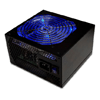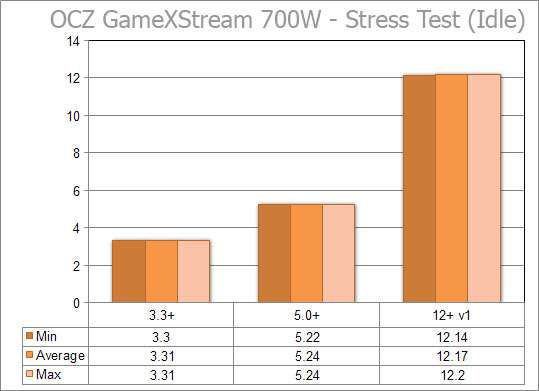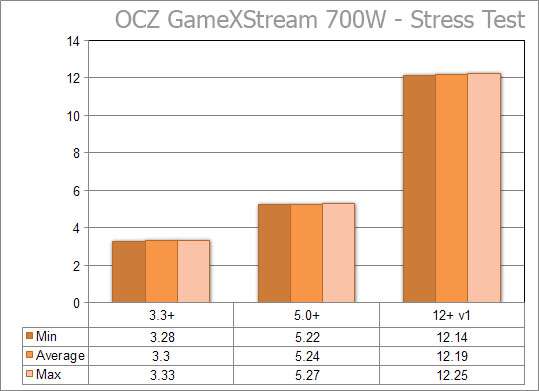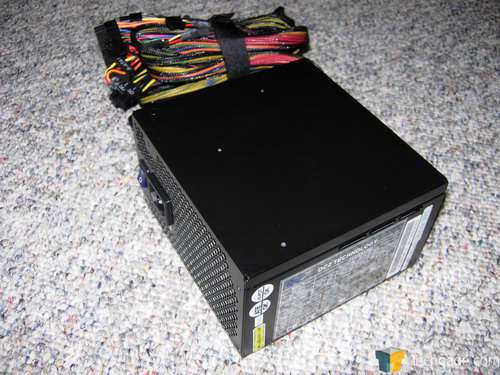- Qualcomm Launches Snapdragon 4 Gen 2 Mobile Platform
- AMD Launches Ryzen PRO 7000 Series Mobile & Desktop Platform
- Intel Launches Sleek Single-Slot Arc Pro A60 Workstation Graphics Card
- NVIDIA Announces Latest Ada Lovelace Additions: GeForce RTX 4060 Ti & RTX 4060
- Maxon Redshift With AMD Radeon GPU Rendering Support Now Available
OCZ GameXStream 700W

Have a beefy system that requires a large PSU, but don’t want to suffer with an ugly unit? OCZ recently released their GameXStream series which are designed with gamers specifically in mind, and promise to deliver “XStream” performance.
Page 3 – Testing, Conclusion
|
|
Ahh, the most important part of any PSU review.. the testing! This is an SLI capable unit, though I do not have SLI. While it’s odd to bench with an SLI PSU without SLI, I believe the power hungry Intel will make up for it. Here are the system specs:
- CPU: Pentium D 820 @ 3.92GHz
- Motherboard: ASUS P5WD2-E Premium w/ 401 BIOS
- Memory: Corsair 2GB PC2-6400PRO (445MHz, 4-4-4-12)
- Video: BFG 6800GT OC 256MB PCI-E
- Sound: Realtek HD Audio
- Storage: WD 200GB 7200 8MB
- Odds and Ends: D-Link WiFi PCI Card
- Etcetera: Windows XP Professional w/ SP2, NVIDIA 81.98 Drivers
- Cooling: Corsair Nautilus 500 Water Cooling
Despite the lack of SLI, the 6800GT is still a power hungry card by it’s own right. The CPU is massively overclocked, and also proves the largest power drain in the entire system. The system includes three 120mm fans, not including the one in the power supply. I am using the Corsair Nautilus 500 for cooling, which also adds to the power drain.
To stress the system, I ran an instance of Prime95s Small FFT test on each CPU core. In addition, RTHDRIBL was run to stress the GPU, and the new stress test with EVEREST 3.0 was also run. These four tests ran constantly for the course of four hours. All of the results were grabbed using Everests log feature, which does a great job of grabbing values from the BIOS and spitting them out into an HTML file. Note that the PSU has 4 +12 rails, however Everest only will monitor one. I do not have a multimeter as of yet to grab proper rail information for +12v2 – +12v4.


The rails overall were pretty stable, although I have two concerns. The biggest concern is the fact that the +5 rail broke through ATX standards and hit 5.27v, which is 0.02v above the said standard. Second, the +12v1, which focuses solely on the CPU, fluctuated quite a bit from 12.14 to 12.19. While this is not a huge concern, it was quite apparent because it happened very often.
Overall, this is a solid PSU. It looks great, includes every connector you should ever need and is actually relatively quiet. The sleeved cables pretty much won me over in terms of it’s looks though. If a PSU is not modular, this is the next best thing. It’s must easier to keep control of the cables, and looks far better.
Two things concern me about the GameXStream though. First off would be the +5 rail pushing beyond the ATX2.0 spec, which it definitely shouldn’t. I actually haven’t reviewed a PSU before that had more than a 5% delta. Considering that this PSU is designed to handle large systems, I am surprised that my rather small Intel caused the rails to fluctuate. What’s even more bizarre though, is that no other reviews of this PSU I have read, have had similar fluctuations. Many of the reviews had much tighter rail results than I had, so chances could be that I received a less than perfect PSU.
The second problem would be the small heatsinks. With the power that this unit holds, and the extra available space inside, one would expect larger sinks. As mentioned earlier, some people have reported their GameXStream getting hotter than they should be, and I believe larger heatsinks could prevent this.
These two problems aside, This is a pretty solid PSU. I would have no problem recommending it, however just keep the two above mentioned issues in mind. Considering I seem to be one of the very few who have had problems with the rails, I cannot guarantee this is a common problem. These PSU’s have been out for a few months now though, and I have not heard of any large issue to speak of. If you decide to pick one up, you won’t regret it. I am awarding the PSU an 8/10.
- Pros
- Great looking
- Larger 120mm fan
- Sleeved cables
- Great size.. will fit in your case
- Cons
- +5 rose slightly above ATX standard
- +12 rail fluctuated more than I’d like
If you have a comment you wish to make on this review, feel free to head on into our forums! There is no need to register in order to reply to such threads.

|
|
Support our efforts! With ad revenue at an all-time low for written websites, we're relying more than ever on reader support to help us continue putting so much effort into this type of content. You can support us by becoming a Patron, or by using our Amazon shopping affiliate links listed through our articles. Thanks for your support!






